We hope that you greatly enjoy and appreciate this article about 3 Astonishing African Lizards. It has been a great pleasure compiling it for you. While all parts of the world hold their share of natural marvels, this region just seems to take the principle to new levels.
Lizards certainly aren’t the only type of life to flourish here, to be sure. In fact, even these 3 Astonishing African Lizards only scratch the surface of the similar species living here. We hope, however, that these serve to whet your appetite to learn of more. Enjoy!
Jackson’s Chameleon
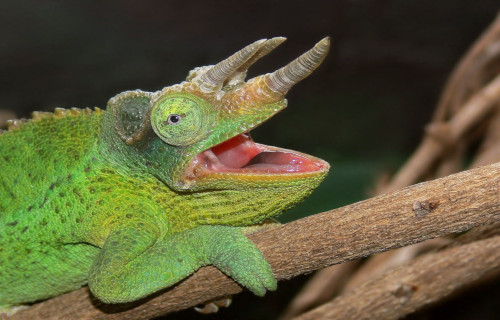
CCL: https://bit.ly/3faMiVU
Jackson’s Chameleon Facts
- Leading off this list of 3 Astonishing African Lizards is the visually befuddling creature known simply as Jackson’s Chameleon.
- The term for it, though, actually serves as just one of the common names for a particularly distinctive species of reptile. In fact, this remarkable creature actually remains known by quite a wide variety of common names. Some may surprise you.
- Some of these include such colorful names as the horned chameleon, Jackson’s Horned Chameleon, and even the Kikuyu three-horned chameleon. Its scientific name, however, remains that of the somewhat hard to pronounce Trioceros jacksonii.
- By either of these many names, though, it represents a truly fascinating animal. The renowned Belgian-British zoologist George Albert Boulenger made the first official recognition of it as a separate species. This acknowledgement occurred in the year 1896.
- Quite fortunately, for the moment, at least, its population appears to be remaining both stable and sufficient. This further holds true throughout the entirety of its range. As a result, the IUCN currently lists it as Least Concern on its Red List.
- The marvelous Jackson’s Chameleon nonetheless faces some potential threats to its existence as a species. One of these involves the presence of invasive species in its native range. Its greatest global threat, though, no doubt consists of climate change.
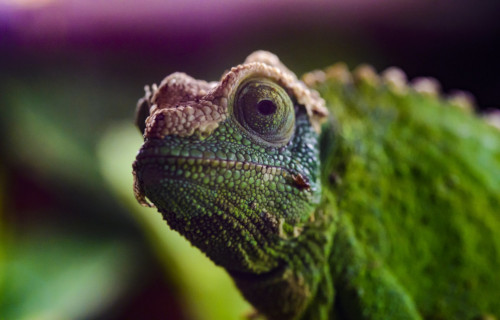
CCL: https://bit.ly/2UqsmXe
Jackson’s Chameleon Physical Description
It bears noting that, while the fascinating Jackson’s Chameleon truly impresses one, it does not do so due to sheer size. Somewhat surprisingly to some, this specific reptile only ranks as a roughly average-sized species among its many relatives in its Order.
It does, however, amaze the viewer in other ways. For one, the animal displays the physiological trait of sexual dimorphism in not one, but two separate ways. Although not unknown, this degree of gender-based differentiation remains uncommon.
In terms of overall size, the males of the species attain a respectably greater size than their female counterparts. He reaches an average head-to-tail length of roughly 15 in (38 cm). She, meanwhile, only grows to an average total length measuring roughly 10 in (25 cm).
The second manifestation of the sex-based differences develops in regards to the horns. The male develops three horns, generally brown in color. Females of the creature, on the other hand, possess no horns at all, distinguishing themselves significantly.
In coloring, though, both genders of the fabulous Jackson’s Chameleon develop essentially the same appearance. This remains changeable, however. The principal color usually presents as bright green, with some shades of yellow or blue, though this changes.
- Kingdom: Animalia
- Phylum: Chordata
- Class: Reptilia
- Order: Squamata
- Family: Chamaeleonidae
- Genus: Triceros
- Species: T. jacksonii
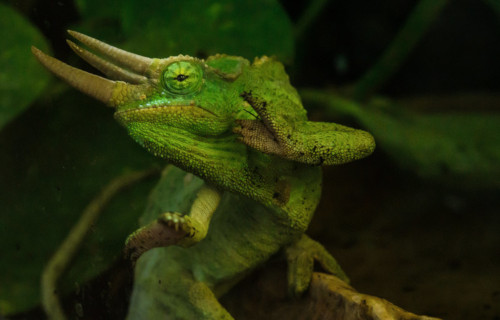
CCL: https://bit.ly/2UqsmXe
Jackson’s Chameleon Distribution, Habitat, and Ecology
Despite the fact that it has now been spread to other parts of the world, the Jackson’s Chameleon evolved as native to only a small are of the globe. More specifically, it develop as endemic to portions of what’s now the countries of Tanzania and Kenya, in Africa.
Now, though, the animal appears in the wild in several other regions. Through the actions of man it now inhabits, in small numbers, portions of the Hawaiin Islands, Florida, in the United States. Unconfirmed reports of sightings in other areas also exist.
Wherever it appears, the distinct reptile has proven itself to be reasonably flexible in terms of specific habitat. In its natural range, it lives at altitudes between 5,250 -8,010 ft (1,600 – 2,440 m). In Hawaii, however, it now appears between 330 – 3,280 ft (100 – 1,000 m).
Within all these places, though, the Jackson’s Chameleon prefers to make its home in regions of local forests and woodlands. It further requires these various areas to have ample amounts of rainfall, and temperate to tropical temperature ranges for its survival.
Just as its many close relatives, it evolved as purely carnivorous in nature. For this, its adaptive camouflage serves it perfectly, It primarily consumes large quantities of various insects, such as isopods, millipedes, spiders, centipedes, snails, and sometimes small lizards.
It further distinguishes itself in one more manner. Most chameleons lay eggs, but not this one. This species gives live birth, typically to between 8 – 30 young. Finally, while most related creatures are highly territorial, this one typically remains much less so.
Golden Armadillo Lizard
Golden Armadillo Lizard Facts
- The next entry into this compendium of 3 Astonishing African Lizards is the somewhat deceptively named Golden Armadillo Lizard.
- As one can easily see, the remarkable certainly represents an incredible species of reptile. Not at all surprisingly, this remarkable lizard also evolved as endemic solely to certain desert regions in only one highly specific portion of the globe.
- The reptile also remains a unique species of animal. That holds true partly due to its rather fascinating defense mechanism. This approach to defense constitutes rolling into a tight ball, which makes it appear larger to would-be predators.
- This surprising action, which some insects share, also presents would-be attackers with its thick, armored exterior. As a result of this remarkable defensive strategy, very few predators invest the time and effort necessary to penetrate this defense.
- The IUCN previously listed the Golden Armadillo Lizard as Vulnerable, on its Red List. Thankfully, however, the organization recently downgraded that status to Least Concern. This action occurred due to a welcome virtual cessation in the pet trade.
Golden Armadillo Lizard Physical Description
Perhaps most notably, the extremely fascinating Golden Armadillo Lizard remains a moderately sized reptile. Yet that fact does not diminish its truly fascinating nature. That’s because what the impressive creature lacks in size it more than makes up for in other ways.
In appearance, the marvel of Nature generally displays visually striking patterns. That’s because its typical colors range from a light brown to a dark brown on top. The underbelly of the Golden Armadillo Lizard, however, appears yellow, with a black pattern.
Individual specimens, meanwhile, range in size from 6.5-8.5 in (16-21 cm) in length. Unlike some relatives, it displays no discernible sexual dimorphism. Its bite further measures so powerful for a creature of its size that it can literally break its own jaws when it bites.
- Kingdom: Animalia
- Phylum: Chordata
- Class: Reptilia
- Order: Squamata
- Family: Cordlidae
- Genus: Ouroboros
- Species: O. cataphractus
Golden Armadillo Lizard Distribution, Habitat, and Ecology
The amazing Golden Armadillo Lizard also evolved as endemic to a highly specific portion of southern Africa. Even more specifically, though, the magnificent animal only thrives in portions of the Northern and the Western Cape provinces of South Africa.
The fascinating reptile also apparently prefers scrub brush and rocky areas for its habitat, at least as a general principle. Despite the great heat of this habitat, it nonetheless remains a diurnal creature, being active during the day and sleeping at night.
Quite remarkably, unlike most lizards, the fascinating reptile also typically lives in social groups. Even more amazingly, these groupings sometimes number as many as 60 individuals. More commonly, though, these groups number around 30 individuals.
Although technically omnivorous, its diet consists primarily of small invertebrates such as insects and spiders. Yet termites appear to be its favorite prey. It nevertheless occasionally supplements this with various plant species sharing its range.
The Golden Armadillo Lizard animal also has an average lifespan measuring approximately 10 years. Individuals also typically make their home in cracks in boulders, or crevices. Finally, it represents one of the few lizards that gives birth to live young.
Knysna Dwarf Chameleon
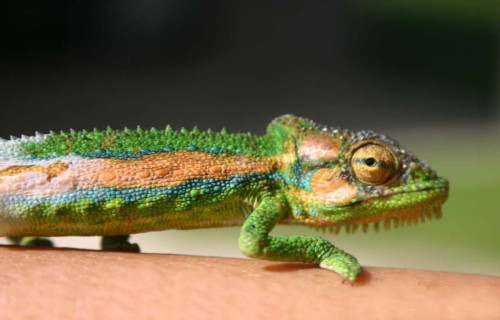
CCL: http://bit.ly/2QZT99x
Knysna Dwarf Chameleon Facts
- The final creature appearing in this article about 3 Astonishing African Lizards is the awesome one known as the Knysna Dwarf Chameleon.
- Perhaps most notably, the remarkable reptile easily qualifies as one of the smallest of all known chameleon species. Many also consider it to be one of the most colorful of all its related species. That says a lot, given their well-deserved reputation.
- Admittedly, however, all its known extant relatives rank as comparatively distant, genetically. Its many wonders do not simply stop there, however. That’s because the marvel of Nature also stands apart from other lizards for another reason.
- That’s due to a fact considered quite fascinating by professional researchers. This holds true since the diminutive lizard appears to be an entirely separate basal offshoot of the common ancestors of all members of the Bradypodion genus.
- Fortunately, for the moment, its numbers also appear to be relatively stable within its habitat range. Sadly, that area also remains highly restricted, however. Due to that regrettable fact, this animal currently lists as Endangered, with the IUCN.
- The Knysna Dwarf Chameleon does face certain ongoing threats to its existence as a species. Not surprisingly, the greatest threats to its continued existence appear to be climate change and habitat loss, much like many other creatures.
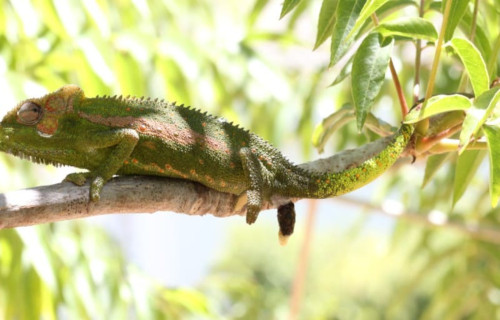
CCL: http://bit.ly/2IjEG4n
Knysna Dwarf Chameleon Physical Description
Not surprisingly, as the common name implies, the Knysna Dwarf Chameleon constitutes a relatively tiny species. That remains true due to the simple fact that its overall length only averages about 5 in (12.5 cm). That measurement even includes the tail.
Another physical characteristic also distinguishes this particular reptile from related species. That’s because, relative to body length, it has the longest tail of any member of its genus. Its remarkable tongue can also extend twice the length of its body.
The species displays sexual dimorphism in the form of color variations between the genders. Firstly, the females typically appear either gray or brown in color. Secondly, the males generally present a bright green with streaks of pink, red, or yellow.
Like all chameleons, the Knysna Dwarf Chameleon also possesses the rather amazing ability to change its colors at will. But, it does remain unlike other lizards in one more manner. Unlike others of its kind, individuals give birth to live young, instead of laying eggs.
- Kingdom: Animalia
- Phylum: Chordata
- Class: Reptilia
- Order: Squamata
- Family: Chamaeleonidae
- Genus: Bradypodion
- Species: B. damaranum
Knysna Dwarf Chameleon Distribution, Habitat, and Ecology
Understandably, the awesome Knysna Dwarf Chameleon only lives in one very specific area. That region consists of in and around the Knysna region of South Africa, on the continent of Africa. It still remains unclear whether its range ever extended further or not.
Somewhat more specifically, within that zone, it only inhabits the Afromontane forests of the region. The onset of human encroachment on its habitat, however, quickly forced it to adapt. As a result, the intriguing species often adapts to living in gardens.
The incredible further creature has an insectivorous diet that consists of various local invertebrates. In its native habitat, the principal predators include snakes and birds. When individuals inhabit gardens they face the threats of pesticides and human activities.
Fortunately, the impressive 42 acre (17 hectares) Steenbok Nature Reserve lies within the endemic territory of the Knysna Dwarf Chameleon. Thankfully for the small marvel, this fact currently provides the creature with at least a small measure of protection.
3 Astonishing African Lizards
Its our sincere hope that you thoroughly enjoyed reading and learning from this article about 3 Astonishing African Lizards. After all, Nature created a mind-blowing assortment of species in this region. Though lizards aren’t the only examples, they certainly merit appreciation.
Sadly, however, many of the forms of life found here, as in other parts of the world, now find themselves in dire peril. The dangers they face vary, of course, but we humans are often at the heart of it. It’s up to us to do all that we can to protect and preserve them all.
Check out our other articles on 5 Spectacular North Carolina Spiders, The Mighty Tornado, 6 Marine Apex Predators, Earth’s 7 Rarest Butterflies, 4 Bulgarian Geological Marvels
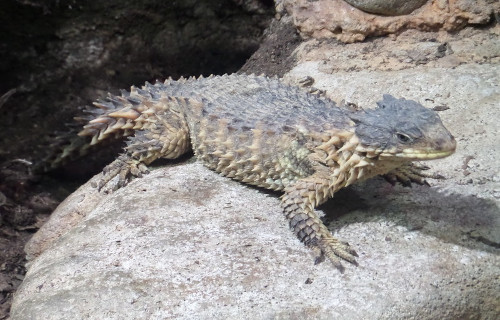
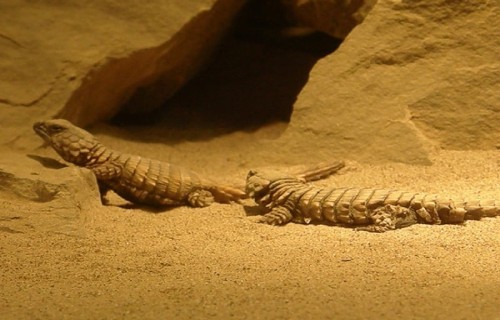
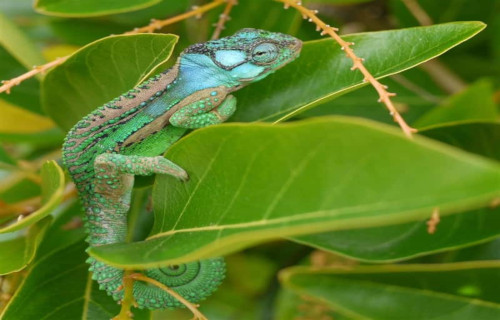









Leave a Reply